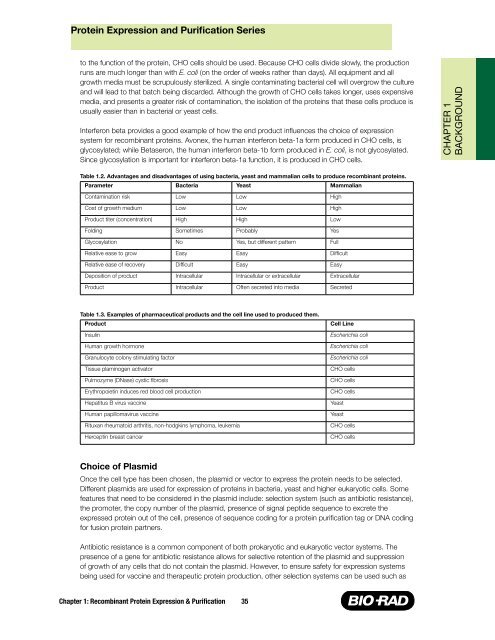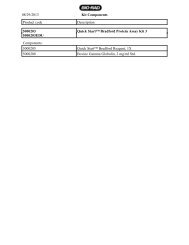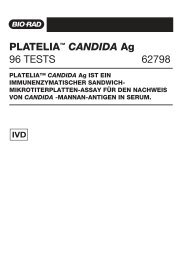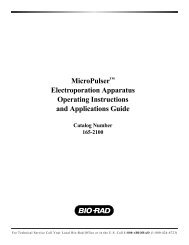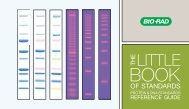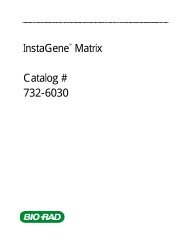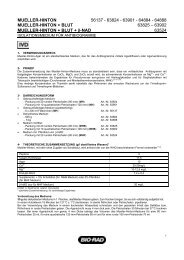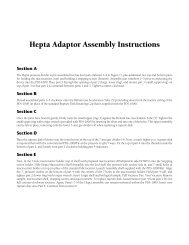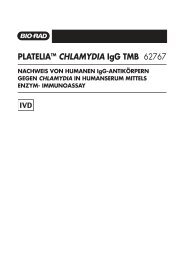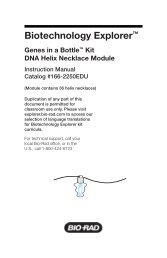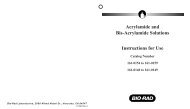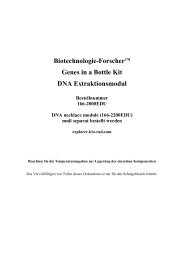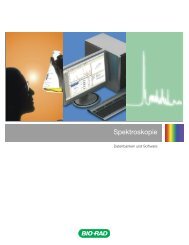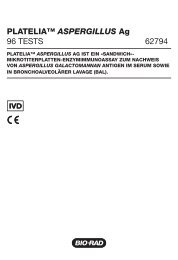Protein Expression and Purification Series - Bio-Rad
Protein Expression and Purification Series - Bio-Rad
Protein Expression and Purification Series - Bio-Rad
Create successful ePaper yourself
Turn your PDF publications into a flip-book with our unique Google optimized e-Paper software.
<strong>Protein</strong> <strong>Expression</strong> <strong>and</strong> <strong>Purification</strong> <strong>Series</strong><br />
to the function of the protein, CHO cells should be used. Because CHO cells divide slowly, the production<br />
runs are much longer than with E. coli (on the order of weeks rather than days). All equipment <strong>and</strong> all<br />
growth media must be scrupulously sterilized. A single contaminating bacterial cell will overgrow the culture<br />
<strong>and</strong> will lead to that batch being discarded. Although the growth of CHO cells takes longer, uses expensive<br />
media, <strong>and</strong> presents a greater risk of contamination, the isolation of the proteins that these cells produce is<br />
usually easier than in bacterial or yeast cells.<br />
Interferon beta provides a good example of how the end product influences the choice of expression<br />
system for recombinant proteins. Avonex, the human interferon beta-1a form produced in CHO cells, is<br />
glycosylated; while Betaseron, the human interferon beta-1b form produced in E. coli, is not glycosylated.<br />
Since glycosylation is important for interferon beta-1a function, it is produced in CHO cells.<br />
Table 1.2. Advantages <strong>and</strong> disadvantages of using bacteria, yeast <strong>and</strong> mammalian cells to produce recombinant proteins.<br />
Parameter Bacteria Yeast Mammalian<br />
Contamination risk Low Low High<br />
Cost of growth medium Low Low High<br />
Product titer (concentration) High High Low<br />
Folding Sometimes Probably Yes<br />
Glycosylation No Yes, but different pattern Full<br />
Relative ease to grow Easy Easy Difficult<br />
Relative ease of recovery Difficult Easy Easy<br />
Deposition of product Intracellular Intracellular or extracellular Extracellular<br />
Product Intracellular Often secreted into media Secreted<br />
Table 1.3. Examples of pharmaceutical products <strong>and</strong> the cell line used to produced them.<br />
Product Cell Line<br />
Insulin Escherichia coli<br />
Human growth hormone Escherichia coli<br />
Granulocyte colony stimulating factor Escherichia coli<br />
Tissue plaminogen activator CHO cells<br />
Pulmozyme (DNase) cystic fibrosis CHO cells<br />
Erythropoietin induces red blood cell production CHO cells<br />
Hepatitus B virus vaccine Yeast<br />
Human papillomavirus vaccine Yeast<br />
Rituxan rheumatoid arthritis, non-hodgkins lymphoma, leukemia CHO cells<br />
Herceptin breast cancer CHO cells<br />
Choice of Plasmid<br />
Once the cell type has been chosen, the plasmid or vector to express the protein needs to be selected.<br />
Different plasmids are used for expression of proteins in bacteria, yeast <strong>and</strong> higher eukaryotic cells. Some<br />
features that need to be considered in the plasmid include: selection system (such as antibiotic resistance),<br />
the promoter, the copy number of the plasmid, presence of signal peptide sequence to excrete the<br />
expressed protein out of the cell, presence of sequence coding for a protein purification tag or DNA coding<br />
for fusion protein partners.<br />
Antibiotic resistance is a common component of both prokaryotic <strong>and</strong> eukaryotic vector systems. The<br />
presence of a gene for antibiotic resistance allows for selective retention of the plasmid <strong>and</strong> suppression<br />
of growth of any cells that do not contain the plasmid. However, to ensure safety for expression systems<br />
being used for vaccine <strong>and</strong> therapeutic protein production, other selection systems can be used such as<br />
Chapter 1: Recombinant <strong>Protein</strong> <strong>Expression</strong> & <strong>Purification</strong><br />
35<br />
CHAPTER 1<br />
BACKGROUND


